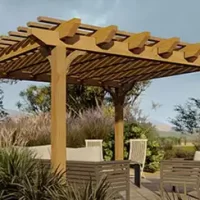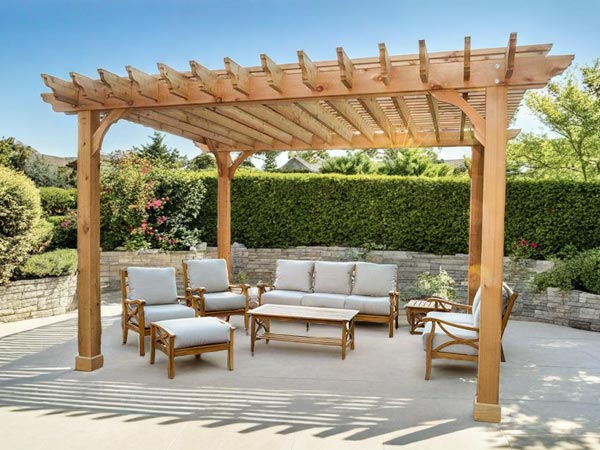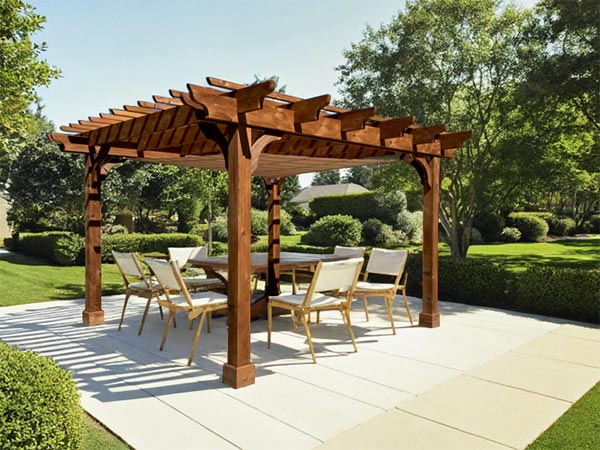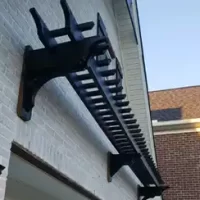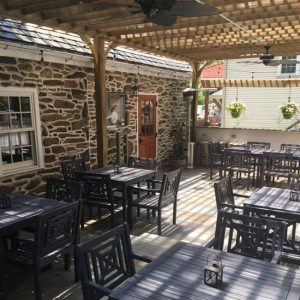
That’s right. Built in Florida, and shipped coast-to-coast, our wood pergola kits are hand cut and hand drilled for shipping anywhere in the lower 48 states. Engineered to withstand extreme weather in California so you can enjoy your pergola for many years. Our ready-to-assemble kits make a great DIY project, or the perfect patio add-on for your favorite California contractor to help install.
California landscaping has many different styles, including city, suburban, mountain, and oceanside. One common thread for property-owners in each type of location is a desire to create a welcoming outdoor gathering place for family and friends that offers some shade and style.
Popular pergola kits for California include functionality to provide maximum coverage to block the beautiful California sun. What features are most important in your landscape plans?

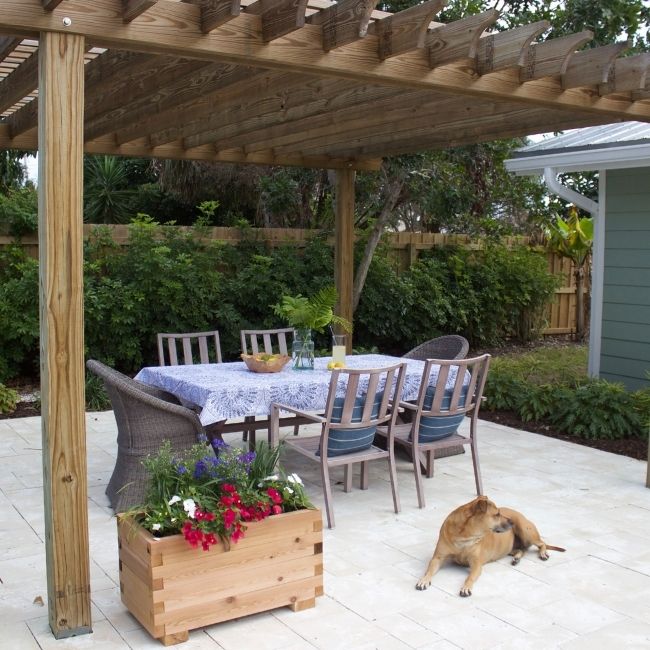
Not sure where to begin to select your new DIY California pergola? First, consider the style that will work in your location. Not surprisingly, the style of pergola kits California residents prefer are those that are built to withstand severe weather, and those that provide shade and protection from rain.
Top Picks for DIY California Pergola Kits
Top choices for patio covers with California style are solid wood structures with stylish form as well as function. Our top selling full-size pergola products, the Big Kahuna pergola kit, the Big Kahuna Solar-ready, and the Sombrero pergola kit, are manufactured to provide those features. Built-in freestanding or attached, both styles offer the most coverage of any of our California pergola kits with a beautiful classic look. Standard sizes start at 8-foot rafters by 8-foot beams all the way up to 20-foot rafters by 20-foot beams, which creates a sizable shade cover over any backyard patio.


What is the Most Popular Pergola San Diego Residents (and Beyond) Choose?
The most popular pergola San Diego residents choose (as well as residents beyond the city) are our Big Kahuna pergolas. The Big Kahuna was originally designed to withstand severe weather that’s typical in Florida, so this sturdiness is also effective with West Coast winds and harsh climate found in the Golden State. Other California pergola style favorites are those with enough coverage to provide some shade, but not block the breeze such as our Sombrero medium shade pergola kits.
This pergola design blends very well with landscapes such as downtown patios, oceanfront, desert, or mountainous regions. Other features homeowners add to their patio design are outdoor game areas and swimming pools, which pair well with an outdoor shade cover for escaping the afternoon sunshine.
Another sought-after feature of the Big Kahuna is its classic shape and structure. Pergolas are a landscape feature that offers coverage from hot sunny days, but also a design element to enhance the look of an otherwise dull and simple patio or deck.
Landscape designers can add columns or pavers surrounding the post bases to add some extra flair, and plants that bloom throughout the year will keep any patio lively and fresh with color. A freestanding style pergola works well if you’re trying to build a more shaded are over your patio. You can create an attractive seating area away from your main living space and add a retractable pergola canopy for extra coverage.
Browse DIY California Pergola Kits

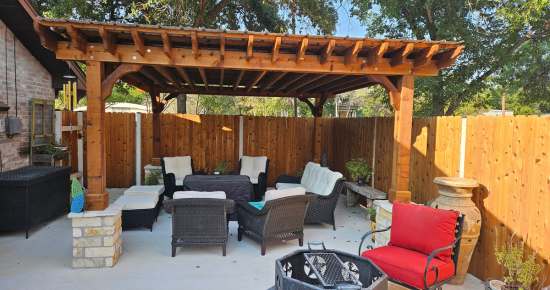


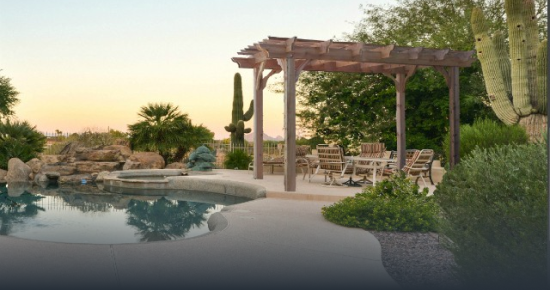


How to Find a Pergola Los Angeles or Anaheim Styled
Whether you’re a city-dweller in downtown Los Angeles or out in the suburbs you may be wondering how and where to get started on your pergola project to find a style that blends with your Los Angeles home or commercial space!
If you’re just getting started with your patio design, remember while you’re measuring to allow space if you’re planning to include a couch or daybed, some armchairs and ottoman, or a few side tables. If you’re looking to add a cover to your restaurant or cafe for outdoor seating, a covered pergola is a great way to ensure you’re covered for all season dining!
Whatever extra items you’re envisioning in your California-style patio, go ahead and plan for those while you’re choosing your pergola size. Then you’ll want to think about shade and style.
If you’re looking for max coverage, the Big Kahuna PLUS covered pergola kits provide the most coverage followed by the Big Kahuna standard, and the Sombrero. The Sombrero is the second most popular choice in the Golden State.
When you’re comparing between attached pergolas and freestanding, you’ll want to account for how much wall space you have for a wall mounted pergola, and you may find that a freestanding is the best way to go. Freestanding pergolas can be ordered in any of our full size wood pergola kits (Big Kahuna, Big Kahuna PLUS, Big Kahuna Solar-ready, Sombrero, and Fedora) as well as the Brim garden pergola.
With a little less coverage than the Big Kahuna, the Sombrero style can create an outdoor pavilion California room in an instant. Simply add outdoor rug and dining set, and roll out your BBQ grill and you’re set to go for outdoor dining under your deck pergola! This style can also be ordered as a structure attached to your house, so if you have a slider right off your kitchen, you can expand the space you entertain and invite more guests!
This may come as a surprise, but a top pergola Los Angeles residents tend to come back to are the Visor or the Brim accent pergolas on the smaller side and the timber frame pergola kits on the larger side. With some areas having limited space to build, these smaller pergolas are a great way to add some flair to an exterior wall, or create a way to add a hammock stand. And that can be accomplished without a large patio or backyard space! Miles and miles away, a favorite pergola Sacramento families choose is also the Brim. Often paired with a full-size shade cover pergola, the Brim can create a border along the edge of a poolside retreat, or along a garden area. For those that have the extra space, choosing a larger frame wood pergola completes your outdoor design with grace and style.
California Timber Frame Style Pergola Kit

Classic timber frame pergola design, built for style and engineered for extreme weather conditions. Built using traditional woodworking techniques including mortised joinery, wood pegs, and quality hardware – our timber frame kits create sturdy and beautiful structures for your backyard project.
Built to last with quality materials and engineered to withstand 175 MPH wind gusts. With rafters on 24-inch centers and top slats on 12-inch centers, any size you choose will provide ample sun coverage.
Freestanding or attached choices available in standard and custom sizes. Available in popular sizes and premium wood, our Big Kahuna Timber Frame pergola kits include shipping to your California location.
Customizations are available for special sizes to accommodate your outdoor project.
Can you Guess Which Pergola Sacramento DIYers Love?

Built standard with posts 6 feet x 6 feet, double 2 feet x 8 feet beams, 2 feet by 8 feet notched rafters, and 2 feet by 2 feet top slats, our Sombrero pergolas offer a little more exposure than the Big Kahuna but with plenty of coverage.
More choices sometimes means more decisions, and can take some time to make. Compare the different pergola styles and sizes, and keep in mind that our standard full-size pergolas can all be ordered in freestanding or attached. Regardless of the style you choose, you’ll want to consider how the pergola will be installed on your patio or in your garden area.
Our pergola post guide provides some information about pergola mounting surfaces, as well as height and the clearance you’ll have under the pergola based on the size posts you choose and how those posts are mounted in the ground.
If you don’t see the size you’re looking for – or know your dimensions are not standard, we also offer custom size pergolas. Custom sizes are sometimes required for projects with an unusual patio size, special height requirements, or an extra large area needed to accommodate commercial pergola kits such as restaurants or entertainment venues. For help finding the correct size, contact us and we can help determine your patio measurements and proper size pergola to fit.
If you follow a couple steps outlined in our guide on How to Measure for a Pergola, you’ll be well on your way to choosing your pergola.
Whether you’re trying to cool off near Death Valley, relax by the beach in San Diego, or lounge on your patio near the redwoods in Northern California, these guidelines will apply for choosing the perfect backyard pergola for your space.
Buy Your California Pergola Kit From Pergola Depot
In addition to our talented customer service team, we offer a pergola comparison guide to help choose the best size and style pergola kit for your backyard and budget. Start shopping today and create the outdoor living room you’ve been dreaming of!




